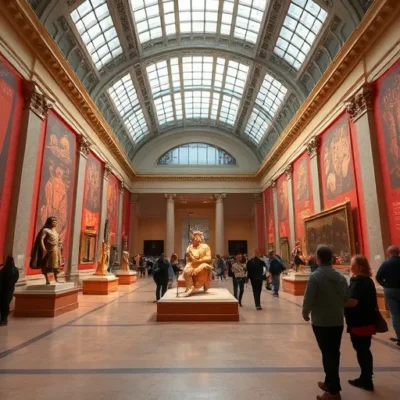A Journey of Nonverbal Hypnosis at the Metropolitan Museum of Art in New York
Hello, this is Hypnosis Creator Tamura.
Recently, I had the opportunity to visit the Metropolitan Museum of Art in New York City. Renowned as one of the top art museums in the world, it holds an extraordinary collection that left me deeply inspired. My visit wasn’t just a casual one; I wanted to explore new ideas for my practice in nonverbal hypnosis, and the museum turned out to be a treasure trove of inspiration.
Central Park: An Oasis of Tranquility
Before heading to the museum, I decided to take a stroll through Central Park. This expansive green space, nestled amidst the bustling city, offers a peaceful escape that’s perfect for reflection. Among its many landmarks, I came across the statue of Balto, a sled dog immortalized for his heroic journey through harsh conditions—a story reminiscent of Japan’s Hachiko.

Sitting by the serene lake in the middle of the park, I found myself captivated by the sight of children playing with remote-controlled boats. This tranquil setting reminded me of the importance of environmental elements in nonverbal hypnosis. Sometimes, it’s the simplest moments of calm that open pathways to the unconscious mind, making us more receptive to creativity and deeper connections.
Exploring the Metropolitan Museum of Art
As I approached the grand entrance of the Metropolitan Museum of Art, its architectural magnificence set the stage for what lay within. The museum is divided into various sections that showcase art and artifacts from across the globe. My first stop was the Oceania section, where intricately carved sculptures revealed the profound spiritual beliefs of the region.
The South American section captivated me with its display of artifacts from the Inca civilization. Gleaming with gold, these items reflected a level of craftsmanship that symbolized power and spirituality. It struck me how these ancient cultures used symbols and rituals to connect with the intangible—an approach not unlike that used in nonverbal hypnosis. Symbols, whether visual or auditory, carry the potential to reach the subconscious mind and evoke profound emotions.

The Power of Symbols in Nonverbal Hypnosis
Throughout my visit, I noticed that many of the artifacts carried deep symbolic meanings. For example, the Nigerian exhibit featured items that were likely used in rituals or spiritual practices. These objects demonstrated how symbols and physical tools can bridge the gap between the conscious and the subconscious. This is a principle I frequently apply in my practice of nonverbal hypnosis, using environmental cues or gestures to guide individuals into a relaxed, receptive state.
One of the most intriguing exhibits was the collection of inscriptions etched into stone murals. These symbols seemed to convey messages that words could not fully capture. Just like in hypnosis, where the tone of voice or a particular gesture can evoke a response more powerful than words, these inscriptions had a mysterious allure that drew me in.
Art and Hypnosis: A Shared Essence
Art, like hypnosis, transcends language. It communicates directly with our emotions and subconscious, creating a unique resonance that words often fail to achieve. Walking through the museum, I was reminded of the universal appeal of art and how its nonverbal communication parallels the practice of hypnosis.

The Metropolitan Museum’s vast array of exhibits also highlighted the universality of human creativity. From the elaborate golden ornaments of the Inca civilization to the ritualistic tools of African cultures, these items embodied a shared human desire to express, connect, and explore the unknown. This realization reinforced my belief in the transformative power of nonverbal hypnosis—a tool that connects people across cultures and backgrounds by tapping into their deepest emotions.
A Lesson in Lifelong Learning
As my visit drew to a close, I reflected on how much I had learned in just a few hours. The exhibits at the museum weren’t just displays of artistic mastery; they were lessons in history, culture, and the human spirit. This experience reminded me of the importance of staying curious and open to new ideas, no matter where we are in life.
Interestingly, the Metropolitan Museum operates on a donation-based system, where visitors can choose how much to pay for admission. This inclusive approach aligns with the museum’s mission of making art accessible to everyone. It was a small but significant reminder that learning and inspiration should have no barriers.

Bringing the Lessons Home
On my way back, I stopped at a subway station where a street musician was performing. His music, raw and heartfelt, added a final touch to a day filled with inspiration. It was a reminder that art isn’t confined to galleries or museums; it exists all around us, waiting to be noticed.
Through my visit to the Metropolitan Museum of Art, I gained a deeper appreciation for the power of symbols, gestures, and environments—elements that are at the core of both art and nonverbal hypnosis. This journey reaffirmed my commitment to exploring new ways of engaging with the subconscious mind, not just as a professional practice, but as a lifelong passion.
Whether it’s through art, hypnosis, or simply observing the world around us, there is always something to learn. And for that, I am deeply grateful.
Feedback
The information online mentioned an entry fee of $25, but in reality, the museum operates on a donation basis, allowing visitors to pay any amount they wish.
The content was rich and incredibly educational.
Learning is truly a lifelong journey.
Hypnotic Cafe
Hypnosis Creator Tamura




Comments